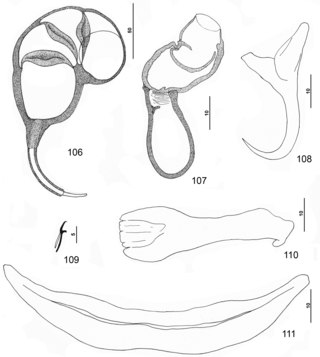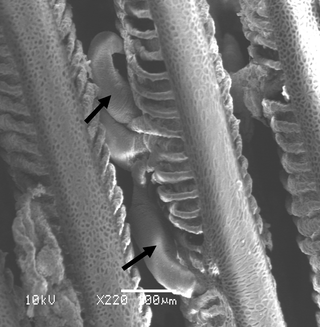
Pseudorhabdosynochus is a genus of monopisthocotylean monogeneans, included in the family Diplectanidae. The type-species of the genus is Pseudorhabdosynochus epinepheli .

Pseudorhabdosynochus epinepheli is a diplectanid monogenean parasitic on the gills of species of groupers. It is the type species of the genus Pseudorhabdosynochus Yamaguti, 1958.

Pseudorhabdosynochus capurroi is a diplectanid monogenean parasitic on the gills of the Black grouper, Mycteroperca bonaci. It was described by Vidal-Martínez and Mendoza-Franco in 1998 and redescribed successively by Yang, Gibson and Zeng in 2005 and by Kritsky, Bakenhaster and Adams in 2015.

Pseudorhabdosynochus firmicoleatus is a diplectanid monogenean parasite on the gills of the Yellowedge grouper, Epinephelus flavolimbatus and the Snowy grouper, Epinephelus niveatus. It was described by Kritsky, Bakenhaster and Adams in 2015.

Pseudorhabdosynochus monaensis is a diplectanid monogenean parasitic on the gills of the rock hind, Epinephelus adscensionis. It has been described by Dyer, Williams & Bunkley-Williams in 1994 and redescribed by Kritsky, Bakenhaster and Adams in 2015.

Pseudorhabdosynochus beverleyburtonae is a diplectanid monogenean parasitic on the gills of the dusky grouper, Epinephelus marginatus. It has been described by Guy Oliver in 1984 as Cycloplectanum beverleyburtonae, redescribed by Oliver in 1987, transferred to the genus Pseudorhabdosynochus by Kritsky & Beverley-Burton in 1986 as Pseudorhabdosynochus beverleyburtonae, redescribed by Kritsky, Bakenhaster and Adams in 2015, and redescribed in 2016 by Chaabane, Neifar, Gey & Justine.
Pseudorhabdosynochus auitoe is a diplectanid monogenean parasitic on the gills of the Highfin grouper, Epinephelus maculatus. It was described in 2007.
Pseudorhabdosynochus buitoe is a diplectanid monogenean parasitic on the gills of the Highfin grouper, Epinephelus maculatus. It has been described in 2007.
Pseudorhabdosynochus duitoe is a diplectanid monogenean parasitic on the gills of the highfin grouper, Epinephelus maculatus. It has been described in 2007.
Pseudorhabdosynochus euitoe is a diplectanid monogenean parasitic on the gills of the Highfin grouper, Epinephelus maculatus. It has been described in 2007.
Pseudorhabdosynochus fuitoe is a diplectanid monogenean parasitic on the gills of the highfin grouper, Epinephelus maculatus. It has been described in 2007.
Pseudorhabdosynochus guitoe is a diplectanid monogenean parasitic on the gills of the Highfin grouper, Epinephelus maculatus. It has been described in 2007.
Pseudorhabdosynochus huitoe is a diplectanid monogenean parasitic on the gills of the highfin grouper, Epinephelus maculatus. It was described in 2007.
Pseudorhabdosynochus cyathus is a diplectanid monogenean parasitic on the gills of the grouper Epinephelus howlandi. It has been described in 2006.
Pseudorhabdosynochus cupatus is a species of diplectanid monogenean parasitic on the gills of groupers.
Pseudorhabdosynochus hargisi is species of a diplectanid monogenean parasitic on the gills of the White grouper Epinephelus aeneus. It was described in 1984 as Diplectanum hargisi and transferred to the genus Pseudorhabdosynochus by Santos, Buchmann & Gibson in 2000. Its systematic position has been clarified by Kritsky, Bakenhaster & Adams in 2015, who differentiated it from Pseudorhabdosynochus americanus.

Pseudorhabdosynochus lantauensis is a diplectanid monogenean parasitic on the gills of the longtooth grouper, Epinephelus bruneus. It was described in 1981 as Cycloplectanum lantauensis and later transferred to the genus Pseudorhabdosynochus by Kritsky & Beverley-Burton in 1986.
Pseudorhabdosynochus melanesiensis is a diplectanid monogenean parasitic on the gills of the grouper, Epinephelus merra. It was described in 1958 as Diplectanum melanesiensis then transferred to the genus Pseudorhabdosynochus by Kritsky & Beverley-Burton in 1986.

Pseudorhabdosynochus riouxi is a species of diplectanid monogenean parasitic on the gills of dusky grouper Mycteroperca marginata. It was described by Guy Oliver in 1986 as Cycloplectanum riouxi, then transferred to the genus Pseudorhabdosynochus by Santos, Buchmann & Gibson in 2000. The species has been redescribed by Chaabane et al. in 2017.
Pseudorhabdosynochus vagampullum is a species of diplectanid monogenean parasitic on the gills of a grouper. It was described in 1969, from eight specimens, under the name Diplectanum vagampullum and transferred to the genus Pseudorhabdosynochus in 1986. The species has been redescribed several times.







